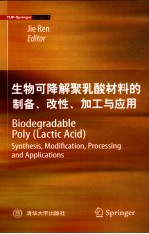图书介绍
生物可降解聚乳酸材料的制备、改性、加工与应用pdf电子书版本下载

- 任杰著 著
- 出版社: 北京:清华大学出版社
- ISBN:9787302236016
- 出版时间:2011
- 标注页数:302页
- 文件大小:38MB
- 文件页数:314页
- 主题词:高聚物-乳酸-复合材料-无污染技术
PDF下载
下载说明
生物可降解聚乳酸材料的制备、改性、加工与应用PDF格式电子书版下载
下载的文件为RAR压缩包。需要使用解压软件进行解压得到PDF格式图书。建议使用BT下载工具Free Download Manager进行下载,简称FDM(免费,没有广告,支持多平台)。本站资源全部打包为BT种子。所以需要使用专业的BT下载软件进行下载。如 BitComet qBittorrent uTorrent等BT下载工具。迅雷目前由于本站不是热门资源。不推荐使用!后期资源热门了。安装了迅雷也可以迅雷进行下载!
(文件页数 要大于 标注页数,上中下等多册电子书除外)
注意:本站所有压缩包均有解压码: 点击下载压缩包解压工具
图书目录
1 Introduction 1
2 Lactic Acid 4
2.1 Introduction 4
2.2 Properties 4
2.3 Preparation 7
2.3.1 Chemical Synthesis 7
2.3.2 Fermentation 7
2.4 Separation and Purification of LA 9
2.4.1 Esterification and Hydrolysis 10
2.4.2 Crystallization 10
2.4.3 Molecular Distillation 11
2.5 Application 12
2.5.1 Raw Materials of PLA 12
2.5.2 Additives in Foods 12
2.5.3 Applications in Cosmetics 13
2.5.4 Applications in Detergents 13
References 14
3 Synthesis and Manufacture of PLA 15
3.1 Direct Polycondensation of Lactic acid 15
3.2 Azeotropic Dehydrative Polycondensation of LA 21
3.3 Polycondensation Kinetics of LA 23
3.4 Ring-Opening Polymerization of Lactide 23
3.4.1 Cationic Ring-Opening Polymerization of Lactide 24
3.4.2 Anionic Ring-Opening Polymerization of Lactide 26
3.4.3 Coordination-Insertion Polymerization of Lactide 28
3.4.4 Enzymatic Ring-Opening Polymerization of Lactide 33
Reterences 35
4 Modification of PLA 38
4.1 Copolymerization of PLA 38
4.1.1 Random and alternating copolymers of PLA 39
4.1.2 Block Copolymers of PLA 45
4.1.3 Multi-Block Copolymers of PLA 52
4.1.4 Graft or Branched Copolymers of PLA 54
4.1.5 Star-Shaped Copolymers of PLA 56
4.1.6 Dendritic Copolymers of PLA 65
4.2 PLA Blending 68
4.2.1 PLA/HA 69
4.2.2 PLA/PEG 72
4.2.3 PLA/PHB 78
4.2.4 PLLA/PDLA 81
4.2.5 PLLA and PDLLA/PCL 85
4.2.6 PLA/PBS 91
4.2.7 PLA/PHEE 94
4.2.8 PLA/PMMA 95
4.2.9 PLA/PVA 95
4.2.10 PLA/PBAT 97
4.3 Composites 99
4.4 Additives 100
4.4.1 Additives for PLA 100
4.4.2 PLA Crystallization Behavior and Nucleating Agents 124
4.5 New Modifiers for PLA 129
4.5.1 Core-Shell Impact Modifiers 129
4.5.2 Nanocomposites 130
References 136
5 Processing of PLA 142
5.1 Injection 142
5.1.1 PLA Injection Molding 142
5.1.2 Controlling Crystallinity in Injection Molded PLA 146
5.1.3 Mechanical Properties of Injection-Molded Poly(L-Lactic Acid) 147
5.1.4 Porous Lamellar Poly(L-Lactic Acid)Scaffolds Made by Conventional Injection Molding Process 148
5.1.5 Shear Controlled Orientation in Injection Molding of PLLA 150
5.2 Spinning 152
5.2.1 Melt Spinning of PLA 153
5.2.2 Dry Spinning of PLA 161
5.2.3 Wet Spinning of PLA 167
5.2.4 Dry-Jet-Wet Spinning of PLA 168
5.2.5 Dyeing of PLA Fibers 170
5.2.6 Electrospinning of PLA Fibers 173
5.3 Blowing 179
5.3.1 Properties for Packaging 179
5.3.2 Process of Blown Film 184
5.3.3 Modification of Blown Film 185
5.4 Foaming 186
5.4.1 Modification of PLA and Its Foam 187
5.4.2 Starch/PLLA Hybrid Foams 190
5.4.3 PLA/PBAT Blend Foams 195
5.4.4 PLA Nanocomposite Foams 201
References 204
6 Application in the Field of Commodity and Industry Product 208
6.1 Packaging Materials 208
6.2 Fiber and Nonwoven 209
6.2.1 PLA Fibers 209
6.2.2 Application Of PLA Fibers 210
6.3 Engineering Plastic 220
6.4 Disposable Ware 222
6.4.1 What Is the Difference Between Biodegradable and Compostable? 223
6.4.2 About PLA for Disposable Use 224
6.4.3 Commercial PLA Disposable Ware 226
6.5 Biodegradable Hot Melt Adhesive Based on PLA and Other Biodegradable Polymer 229
6.5.1 Biodegradable PLA and/or PCL Based Biodegradable HMAs 229
6.5.2 PHBV and PEA Based on Biodegradable HMAs 231
6.5.3 Natural Polymer Based on Biodegradable HMAs 233
Reference 236
7 Application in the Field of Biomedical Materials 240
7.1 Tissue Engineering Scaffold 240
7.1.1 Design Principles of Tisssue Engineering Scaffold 240
7.1.2 PLA Materials and Modification for Tissue Eningeering Scaffold Application 241
7.1.3 Surface Hydrophilicity Modifications 244
7.1.4 Biomimetic ECM Modification 245
7.1.5 PLA/Apatite Composite 248
7.1.6 Preparation of Tissue Engineering Scaffolds 250
7.1.7 Thermally Induced Phase Separation 251
7.1.8 Solvent Casting/Particulate Leaching 251
7.1.9 Gas Foaming 252
7.2 Controllable Drug Delivery Based on PLA 253
7.2.1 Introduction to Drug Delivery Based on PLA 253
7.2.2 Science of Controllable Drug Delivery 254
7.3 Other Biomedical Appliances 260
7.3.1 PLA Used For Surgical Sutures 260
7.3.2 Ideal Filler for Soft Tissue Augmentation 261
7.3.3 Mesh Insertion for Groin Hemia Repair 264
Reference 267
8 Standard and Test Methods 273
8.1 Biodegradation of PLA 274
8.1.1 Definifion of Biodegradation 274
8.1.2 Factors Affecting the Biodegradation Behaviour of PLA 274
8.1.3 Abiotic Degradation 275
8.1.4 Biotic Degradation 280
8.2 Biodegradation Standards and Certification Systems 283
8.2.1 Biodegradation Standards 283
8.2.2 Different Certitication Systems 289
8.3 Introduction to Some Test Methods 291
8.3.1 Visual Observation 291
8.3.2 Gravimetry 292
8.3.3 Enzyme Assays 292
8.3.4 Plate Tests 292
8.3.5 Respiration Tests 292
8.3.6 Controlled Composting Test 294
Reference 295
Index 297